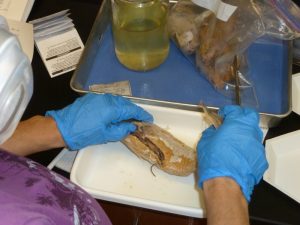Study Advances Food Web Matrix for Improved Atlantis Ecosystem Model
– NOVEMBER 2, 2016
Researchers analyzed diet information for 474 unique fish species to quantify likely contributions of prey to predators’ diets for an improved marine food web matrix model. They identified previously missing predator-prey linkages, recategorized predators and prey into functional groups based on ecological factors, and quantified error ranges to reflect diet variability and data quality. The revised matrix improved Atlantis ecosystem model hindcasts for the entire Gulf of Mexico and predicted population trends more accurately. They published their methods in Fisheries Research: Progression of a Gulf of Mexico food web supporting Atlantis ecosystem model development.
Marine management strategies have shifted focus from analyzing individual components to entire ecosystems for improved future marine ecosystem sustainability. Ecosystem models often consider the diets of hundreds to thousands of species, making it necessary to group species together by niche and dietary habitats. This study contributes improvements to the Atlantis Marine Ecosystem Model – a three dimension biogeochemical model representing ocean physics, nutrient cycling, and high trophic level dynamics and fisheries – that serves as a strategic tool to assess Gulf of Mexico ecosystem dynamics.
The research team performed hierarchical cluster analysis to determine functional groups that have similar prey requirements, then produced a food web diagram representing the interactions between predators and prey. The researchers compared this study’s diet matrix with ten Gulf of Mexico food webs and determined where variation in food web structure exists. A hindcast from 1980 to 2010 using Atlantis showed an improved fit to observational data and reduced error in biomass projections using the revised diet information.
The team found that the revised matrix more closely resembled deepwater food webs than nearshore food webs, suggesting greater variability in predator composition and prey resources in nearshore areas. The missing prey linkages identified in this study may help inform decisions about where targeted sampling efforts should be applied to fill gaps in the current literature and create a greater distinction between inshore/nearshore and reef fish. The researchers noted that integrating additional diet information from other nearshore areas of the Gulf of Mexico would improve the representation of estuarine-dependent interactions and area-specific species assemblages.
This study’s data are publicly available through the Gulf of Mexico Research Initiative Information & Data Cooperative (GRIIDC) at DOI: R4.x267.182:0003.
The study’s authors are Joseph H. Tarnecki, Amy A. Wallace, James D. Simons, and Cameron H. Ainsworth.
***********
This research was made possible in part by a grant from the Gulf of Mexico Research Initiative (GoMRI) to the Center for the Integrated Modeling and Analysis of Gulf Ecosystems II (C-IMAGE II). Other funding sources included the U.S. Department of Commerce’s National Oceanic and Atmospheric Administration (NOAA) Fisheries Southeast Regional Office Marine Fisheries Initiative (NA13NMF4330171), the Marine Resource Assessment Program at the University of South Florida (95-NA10OAR4320143), and the National Sea Grant College Program (NA10-OAR4170079).
The Gulf of Mexico Research Initiative (GoMRI) is a 10-year independent research program established to study the effect, and the potential associated impact, of hydrocarbon releases on the environment and public health, as well as to develop improved spill mitigation, oil detection, characterization and remediation technologies. An independent and academic 20-member Research Board makes the funding and research direction decisions to ensure the intellectual quality, effectiveness and academic independence of the GoMRI research. All research data, findings and publications will be made publicly available. The program was established through a $500 million financial commitment from BP. For more information, visit https://gulfresearchinitiative.org/.
© Copyright 2010-2017 Gulf of Mexico Research Initiative (GoMRI) – All Rights Reserved. Redistribution is encouraged with acknowledgement to the Gulf of Mexico Research Initiative (GoMRI). Please credit images and/or videos as done in each article. Questions? Contact web-content editor Nilde “Maggie” Dannreuther, Northern Gulf Institute, Mississippi State University (maggied@ngi.msstate.edu).






